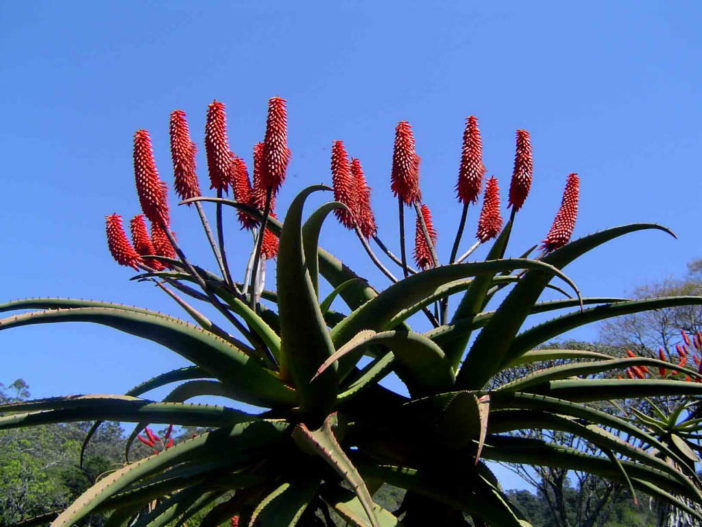Scientific Name
Aloe excelsa A.Berger
Common Name(s)
Noble Aloe, Zimbabwe Aloe, Zimbabwe Tree Aloe
Synonym(s)
Aloe excelsa var. excelsa
Scientific Classification
Family: Asphodelaceae
Subfamily: Asphodeloideae
Genus: Aloe
Description
Aloe excelsa is a succulent tree with a simple stem and fleshy, deeply channeled leaves arranged in a compact rosette at the top of the stem. The stem grows up to 20 feet (6 m) tall. All but the lowest part of the stem is clothed in withered leaf remains. Leaves are dull green, often tinged red, without spots, and with deltoid reddish-brown teeth along margins. They are lance-shaped, spreading, becoming recurved, up to 3.3 feet (1 m) long, and up to 6 inches (15 cm) wide. Young plants have scattered prickles, mainly on the lower surface of the leaves. However, prickles disappear as the plants grow and become less vulnerable to grazing.
The flowers are scarlet to reddish-orange, up to 1.4 inches (3.5 cm) long, and 0.2 inches (0.5 cm0 in diameter, and appear on up to 6-branched inflorescences with densely flowered racemes. The racemes are cylindrical, up to 10 inches (25 cm) long, and up to 2.8 inches (7 cm) in diameter.
This species is frequently confused with the related Aloe ferox and Aloe africana. This is because they look very similar when fully grown. However, the flowers are different, with the racemes of A. excelsa being far shorter and slightly curved.
Origin
The native range of Aloe excelsa is around Mulanje mountain in Malawi, through Zambia, Mozambique, Zimbabwe, and Botswana to Limpopo in South Africa. It grows on rocky outcrops and hillsides.

Hardiness
USDA hardiness zones 9b to 11b: from 20 °F (−6.7 °C) to 50 °F (+10 °C).
How to Grow and Care
Aloe is a very forgiving plant, and a well-grown plant can be quite beautiful. However, as with all succulents, Aloe must never be allowed to sit in stagnant water, and the plant should be carefully monitored to watch for signs of overwatering.
These succulents are not particularly fast-growing and will only rarely need repotting. However, repot Aloes tipping over their pots or have ceased growing in the spring. Use a fast-draining potting mix with one-third of sand or pebbles. When repotting a larger plant, it is possible to divide the root ball carefully. Some varieties of Aloe will send off offsets that can be potted independently.
Aloe plants need strong, bright light. They can withstand full summer sun once acclimated. In the winter, provide bright light. It prefers warmer temperatures of 70 to 80 °F (21 to 27 °C) but will survive down to 40 °F (4.5 °C). Feed with a succulent fertilizer in the summer only. Suspend feeding in the winter as the plant goes dormant.
See more at How to Grow and Care for Aloe.
Links
- Back to genus Aloe
- Succupedia: Browse succulents by Scientific Name, Common Name, Genus, Family, USDA Hardiness Zone, Origin, or cacti by Genus
Photo Gallery
Click on a photo to see a larger version.



